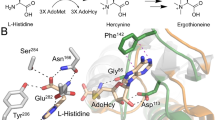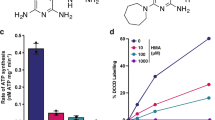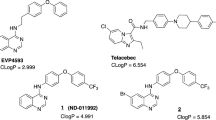Abstract
Isoniazid is a key drug used in the treatment of tuberculosis. Isoniazid is a pro-drug, which, after activation by the katG-encoded catalase peroxidase, reacts nonenzymatically with NAD+ and NADP+ to generate several isonicotinoyl adducts of these pyridine nucleotides. One of these, the acyclic 4S isomer of isoniazid-NAD, targets the inhA-encoded enoyl-ACP reductase, an enzyme essential for mycolic acid biosynthesis in Mycobacterium tuberculosis. Here we show that the acyclic 4R isomer of isoniazid-NADP inhibits the M. tuberculosis dihydrofolate reductase (DHFR), an enzyme essential for nucleic acid synthesis. This biologically relevant form of the isoniazid adduct is a subnanomolar bisubstrate inhibitor of M. tuberculosis DHFR. Expression of M. tuberculosis DHFR in Mycobacterium smegmatis mc2155 protects cells against growth inhibition by isoniazid by sequestering the drug. Thus, M. tuberculosis DHFR is the first new target for isoniazid identified in the last decade.
This is a preview of subscription content, access via your institution
Access options
Subscribe to this journal
Receive 12 print issues and online access
$189.00 per year
only $15.75 per issue
Buy this article
- Purchase on Springer Link
- Instant access to full article PDF
Prices may be subject to local taxes which are calculated during checkout




Similar content being viewed by others
References
Bloom, B.R. & Murray, C.J. Tuberculosis: commentary on a reemergent killer. Science 257, 1055–1064 (1992).
Bernstein, J., Lott, W.A., Steinberg, B.A. & Yale, H.L. Chemotherapy of experimental tuberculosis. V. Isonicotinic acid hydrazide (nydrazid) and related compounds. Am. Rev. Tuberc. 65, 357–364 (1952).
Youatt, J. A review of the action of isoniazid. Am. Rev. Respir. Dis. 99, 729–749 (1969).
Middlebrook, G. Sterilization of tubercle bacilli by isonicotinic acid hydrazide and the incidence of variants resistant to the drug in vitro. Am. Rev. Tuberc. 65, 765–767 (1952).
Zhang, Y., Heym, B., Allen, B., Young, D. & Cole, S. The catalase-peroxidase gene and isoniazid resistance of Mycobacterium tuberculosis. Nature 358, 591–593 (1992).
Zhao, X. The catalytic mechanism of Mycobacterium tuberculosis catalase-peroxidase (katG) and isoniazid activation. PhD thesis. The Graduate Center, City University of New York, Brooklyn, New York, (2005).
Nguyen, M., Claparols, C., Bernadou, J. & Meunier, B. A fast and efficient metal-mediated oxidation of isoniazid and identification of isoniazid-NAD(H) adducts. ChemBioChem 2, 877–883 (2001).
Rozwarski, D.A., Grant, G.A., Barton, D.H., Jacobs, W.R., Jr. & Sacchettini, J.C. Modification of the NADH of the isoniazid target (InhA) from Mycobacterium tuberculosis. Science 279, 98–102 (1998).
White, S.W., Zheng, J., Zhang, Y.M. & Rock, C.O. The structural biology of type II fatty acid biosynthesis. Annu. Rev. Biochem. 74, 791–831 (2004).
Barry, C.E., III. et al. Mycolic acids: structure, biosynthesis and physiological functions. Prog. Lipid Res. 37, 143–179 (1998).
Takayama, K., Wang, C. & Besra, G.S. Pathway to synthesis and processing of mycolic acids in Mycobacterium tuberculosis. Clin. Microbiol. Rev. 18, 81–101 (2005).
Lei, B., Wei, C.J. & Tu, S.C. Action mechanism of antitubercular isoniazid. Activation by Mycobacterium tuberculosis KatG, isolation, and characterization of InhA inhibitor. J. Biol. Chem. 275, 2520–2526 (2000).
Rawat, R., Whitty, A. & Tonge, P.J. The isoniazid-NAD adduct is a slow, tight-binding inhibitor of InhA, the Mycobacterium tuberculosis enoyl reductase: adduct affinity and drug resistance. Proc. Natl. Acad. Sci. USA 100, 13881–13886 (2003).
Zhang, Y., Vilcheze, C. & Jacobs, W.R., Jr. Mechanisms of drug resistance in Mycobacterium tuberculosis. in Tuberculosis and the Tubercle Bacillus (eds. Cole, S.T., Eisenach, K.D., McMurray, D.N. & Jacobs, W.R., Jr.) 115–140 (ASM Press, Washington, DC, 2005).
Basso, L.A., Zheng, R., Musser, J.M., Jacobs, W.R., Jr. & Blanchard, J.S. Mechanisms of isoniazid resistance in Mycobacterium tuberculosis: enzymatic characterization of enoyl reductase mutants identified in isoniazid-resistant clinical isolates. J. Infect. Dis. 178, 769–775 (1998).
Ducasse-Cabanot, S. et al. In vitro inhibition of the Mycobacterium tuberculosis beta-ketoacyl-acyl carrier protein reductase MabA by isoniazid. Antimicrob. Agents Chemother. 48, 242–249 (2004).
Gangadharam, P.R., Harold, F.M. & Schaefer, W.B. Selective inhibition of nucleic acid synthesis in Mycobacterium tuberculosis by isoniazid. Nature 198, 712–714 (1963).
Miller, G.P. & Benkovic, S.J. Stretching exercises—flexibility in dihydrofolate reductase catalysis. Chem. Biol. 5, R105–R113 (1998).
Schnell, J.R., Dyson, H.J. & Wright, P.E. Structure, dynamics, and catalytic function of dihydrofolate reductase. Annu. Rev. Biophys. Biomol. Struct. 33, 119–140 (2004).
Suling, W.J. et al. Susceptibilities of Mycobacterium tuberculosis and Mycobacterium avium complex to lipophilic deazapteridine derivatives, inhibitors of dihydrofolate reductase. J. Antimicrob. Chemother. 42, 811–815 (1998).
Li, R. et al. Three-dimensional structure of Mycobacterium tuberculosis dihydrofolate reductase reveals opportunities for the design of novel tuberculosis drugs. J. Mol. Biol. 295, 307–323 (2000).
Daugelat, S. et al. The RD1 proteins of Mycobacterium tuberculosis: expression in Mycobacterium smegmatis and biochemical characterization. Microbes Infect. 5, 1082–1095 (2003).
Banerjee, A. et al. InhA, a gene encoding a target for isoniazid and ethionamide in Mycobacterium tuberculosis. Science 263, 227–230 (1994).
Alland, D. et al. Identification of differentially expressed mRNA in prokaryotic organisms by customized amplification libraries (DECAL): the effect of isoniazid on gene expression in Mycobacterium tuberculosis. Proc. Natl. Acad. Sci. USA 95, 13227–13232 (1998).
Wilson, M. et al. Exploring drug-induced alterations in gene expression in Mycobacterium tuberculosis by microarray hybridization. Proc. Natl. Acad. Sci. USA 96, 12833–12838 (1999).
Betts, J.C. et al. Signature gene expression profiles discriminate between isoniazid-, thiolactomycin-, and triclosan-treated Mycobacterium tuberculosis. Antimicrob. Agents Chemother. 47, 2903–2913 (2003).
Boshoff, H.I. et al. The transcriptional responses of Mycobacterium tuberculosis to inhibitors of metabolism: novel insights into drug mechanisms of action. J. Biol. Chem. 279, 40174–40184 (2004).
Waddell, S.J. et al. The use of microarray analysis to determine the gene expression profiles of Mycobacterium tuberculosis in response to anti-bacterial compounds. Tuberculosis (Edinb.) 84, 263–274 (2004).
Hughes, M.A., Silva, J.C., Geromanos, S.J. & Townsend, C.A. Quantitative proteomic analysis of drug-induced changes in mycobacteria. J. Proteome Res. 5, 54–63 (2006).
Wilming, M. & Johnsson, K. Spontaneous formation of the bioactive form of the tuberculosis drug isoniazid. Angew. Chem. Int. Edn Engl. 38, 2588–2590 (1999).
Quemard, A. et al. Enzymatic characterization of the target for isoniazid in Mycobacterium tuberculosis. Biochemistry 34, 8235–8241 (1995).
Sawaya, M.R. & Kraut, J. Loop and subdomain movements in the mechanism of Escherichia coli dihydrofolate reductase: crystallographic evidence. Biochemistry 36, 586–603 (1997).
Cody, V., Luft, J.R., Pangborn, W. & Gangjee, A. Analysis of three crystal structure determinations of a 5-methyl-6-N-methylanilino pyridopyrimidine antifolate complex with human dihydrofolate reductase. Acta Crystallogr. D59, 1603–1609 (2003).
Kongsaeree, P. et al. Crystal structure of dihydrofolate reductase from Plasmodium vivax: pyrimethamine displacement linked with mutation-induced resistance. Proc. Natl. Acad. Sci. USA 102, 13046–13051 (2005).
Vilcheze, C. et al. Inactivation of the InhA-encoded fatty acid synthase II (FAS II) enoyl-acyl carrier protein reductase induces accumulation of the FAS I end products and cell lysis of Mycobacterium smegmatis. J. Bacteriol. 182, 4059–4067 (2000).
Stone, S.R. & Morrison, J.F. Kinetic mechanism of the reaction catalyzed by dihydrofolate reductase from Escherichia coli. Biochemistry 21, 3757–3765 (1982).
CCP4. The CCP4 suite: programs for protein crystallography. Acta Crystallogr. D50, 760–763 (1994).
Murshudov, G.N., Vagin, A.A. & Dodson, E.J. Refinement of macromolecular structures by the maximum-likelihood method. Acta Crystallogr. D53, 240–255 (1997).
Emsley, P. & Cowtan, K. Coot: model-building tools for molecular graphics. Acta Crystallogr. D60, 2126–2132 (2004).
Brunger, A.T. Assessment of phase accuracy by cross validation: the free R value. Methods and applications. Acta Crystallogr. D49, 24–36 (1993).
Schuttelkopf, A.W. & van Aalten, D.M. PRODRG: a tool for high-throughput crystallography of protein-ligand complexes. Acta Crystallogr. D60, 1355–1363 (2004).
Acknowledgements
We thank W.R. Jacobs, Jr. (Albert Einstein College of Medicine) for providing plasmid pSD26 and valuable discussions, A. Bhatt for assistance with the MIC experiments and P.F. Cook for valuable discussions concerning bisubstrate inhibitors. This work was supported by a US National Institutes of Health grant to J.S.B. (AI33696).
Author information
Authors and Affiliations
Corresponding author
Ethics declarations
Competing interests
The authors declare no competing financial interests.
Supplementary information
Supplementary Fig. 1
Crystal structures of dihydrofolate reductase from various organisms. (PDF 384 kb)
Rights and permissions
About this article
Cite this article
Argyrou, A., Vetting, M., Aladegbami, B. et al. Mycobacterium tuberculosis dihydrofolate reductase is a target for isoniazid. Nat Struct Mol Biol 13, 408–413 (2006). https://doi.org/10.1038/nsmb1089
Received:
Accepted:
Published:
Issue Date:
DOI: https://doi.org/10.1038/nsmb1089
This article is cited by
-
The pathogenic mechanism of Mycobacterium tuberculosis: implication for new drug development
Molecular Biomedicine (2022)
-
CinA mediates multidrug tolerance in Mycobacterium tuberculosis
Nature Communications (2022)
-
Structure based drug discovery for designing leads for the non-toxic metabolic targets in multi drug resistant Mycobacterium tuberculosis
Journal of Translational Medicine (2017)
-
Characterizing the pocketome of Mycobacterium tuberculosis and application in rationalizing polypharmacological target selection
Scientific Reports (2014)
-
In silico structure-based design of a novel class of potent and selective small peptide inhibitor of Mycobacterium tuberculosis Dihydrofolate reductase, a potential target for anti-TB drug discovery
Molecular Diversity (2010)



